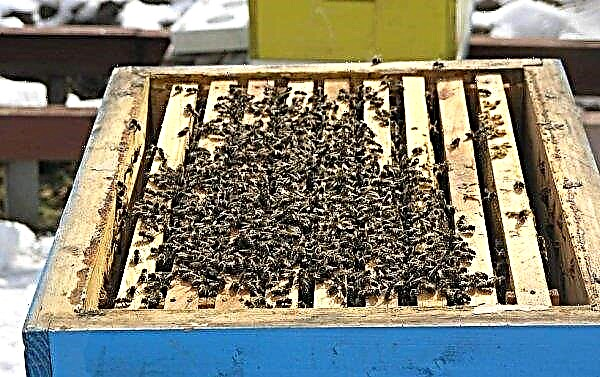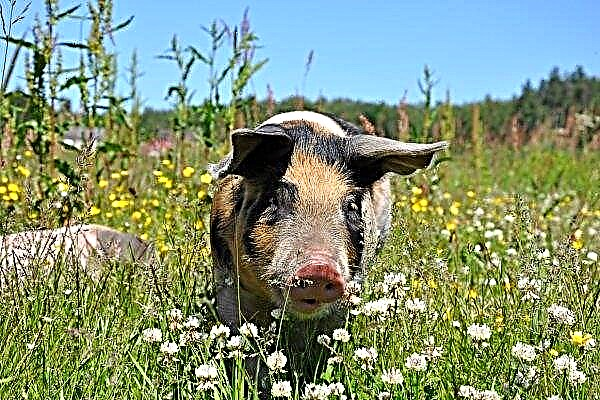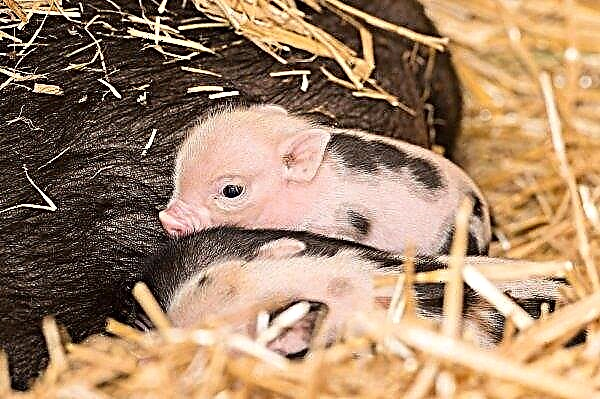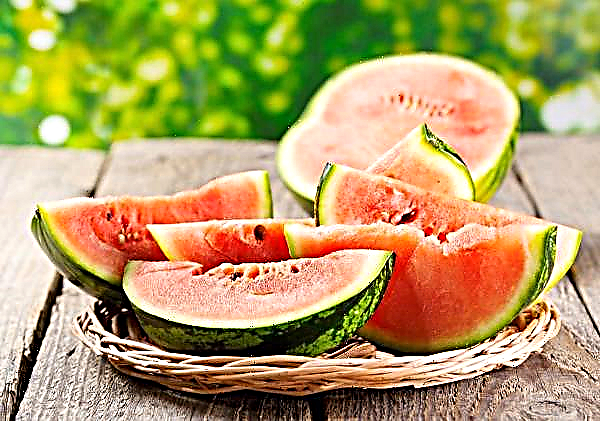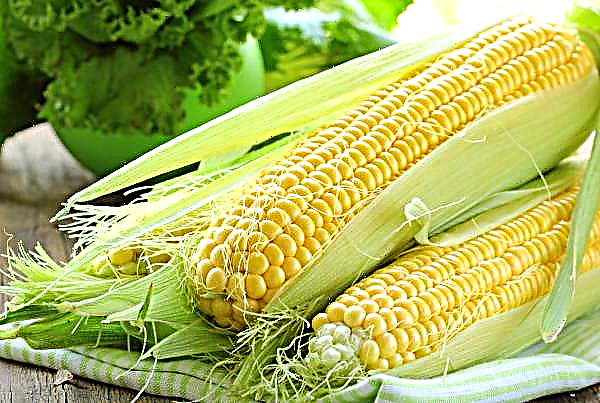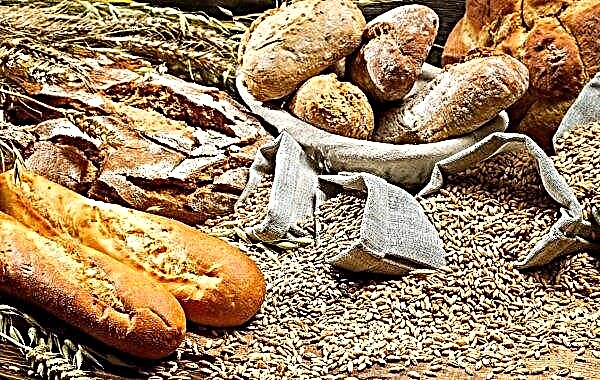Croton is an evergreen perennial growing as a shrub in the tropical jungle of Malaysia and East India. It is widespread as an ornamental houseplant due to its unusual foliage color. When breeding his house, the problem of reproduction often arises. Not everyone knows the ways of croton propagation - we will talk about this later.
How to propagate croton at home
The flower propagates by vegetative (leaf, cuttings, layering) and generative (seeds) methods. The processes themselves are absolutely not complicated, the main thing is to know some subtleties.
Did you know? Croton, or variegated codium, was introduced to Europe after the 50s of the XIX century and is the only representative in its family.
Leaf
You can try to propagate the croton leaf, but this procedure is unlikely to be successful. A single-rooted leaf is not able to form an escape. It can also take root, which is likely to die in time. For a more successful result, you need to take a leaf with a petiole and a kidney, which is at its base. When placed in a substrate, a sleeping kidney wakes up and gives a new life. Deepen the petiole by 2-3 cm into the soil. Then you should create greenhouse conditions and wait for the roots to appear. At the same time, do not forget to irrigate regularly and ventilate the plant daily.
Video: croton leaf propagation
Cuttings
It is easiest to propagate a plant with cuttings. To root them, you can use water or a substrate. The time spent is about the same.
In the ground
To root the stalk in the soil, you need to prepare either a mixture of sphagnum or peat and sand, then fill them with small pots.

Further, the process looks like this:
- A stalk 6–10 cm long is cut from the top of the plant. It should have healthy leaves and a semi-lignified stem. The slice is treated with activated carbon.
- Rinse the cuttings, rinse the juice from it and dry on the fabric for about 2 hours.
- Remove the bottom foliage, and at the top cut off half of the leaf plate.
- In the flowerpot, make holes and place cuttings in them, ramming the soil nearby. In one flowerpot there can be 2-3 petioles.
- Petioles are covered with a plastic glass and placed in a warm place.
- Through the pan, watering the cuttings is carried out so that the soil is constantly moist. Daily airing is carried out.
- The fact that the roots appeared will be indicated by the tense surface of the leaf slices. It usually takes a month and a half.
- Now young plants can be planted in pots.
Important! Cutting croton possible at any time, but best in mid-spring, with the beginning of the growing season.
In water
The preparation of the cuttings is similar to the previous case.
The following actions are performed:
- The end of the handle is immersed in a root solution. So that moisture evaporates less from the plant, its leaves must be twisted into a tube and fastened with an elastic band.
- The container is covered with a plastic glass and placed in a warm bright place. Under a glass, the stalk should not touch the leaves of its walls.
- The temperature in the room where the greenhouse is located should be +23 ... + 25 ° С. Minor deviations from this range, even for a short time, can provoke the onset of putrefactive processes and the death of a seedling.
- When the roots reach 20 mm in length, the stalk can be planted in a substrate with neutral acidity. It is desirable that this be a mixture of turf and leafy land, humus, peat and sand in equal proportions.
Video: croton propagation by cuttings in water
Air layering
This method is best used during a period of partial discharge of foliage by a flower.
- On a bald central stalk at a height of 0.1-0.2 m from the bottom sheet or soil with a knife, make a circular incision of the cortex 10 mm wide.
- Blot the section thoroughly so that it does not ooze milky juice.
- Treat the wound with heteroauxin or root.
- Cover the slice with wet moss or peat and wrap the top with a film, fix it with a twine. It should tightly fix the bottom, and fit freely on top so that the cut breathes and can be moistened.
- Roots appear after 35–45 days. It will be possible to cut the stem when the roots become about 40-50 mm long.
- The resulting stalk is planted in a flowerpot filled with substrate and drainage at the bottom. A week or two, it should be kept under a plastic glass to maintain high humidity. It needs to be aired every day, sprayed, irrigated through a pan.
Important! If you use seeds harvested on your own, then they need to be planted in the same year, as their germination rate is quickly lost.
Seeds
This method is not often used, since it is very time consuming and troublesome. It is advisable to sow the collected seeds in the last decade of February.
- A shallow container 20–25 cm long is suitable as a container.
- It is filled with a mixture of sand and peat (2: 1) or just sand. The soil is being moistened.
- The seed is soaked for 12-15 hours in water and another 2-3 hours in a growth stimulator.
- The finished seed is laid out on top of the substrate and slightly pressed into it by 10 mm. Sprinkled with peat on top.
- The container is covered with a film and kept at a temperature of + 22 ° C. The soil is moistened through a pallet.
- After a month, shoots should appear.
- Fortified seedlings dive on individual flowerpots.

Common breeding errors
Although the processes described above are absolutely not complicated, inexperienced flower growers often make mistakes due to which their flowers grow poorly.
Did you know? When croton came to Europe, the locals believed that the flower can be grown only at high temperatures, so it is impossible to plant it at home. Accordingly, it was planted only in the southern regions in gardens.
Among the common mistakes are the following:
- Early separation of the mother leaf from young shoots. There is no need to rush to pick it off, since it is a source of nutrition for a young plant - let the shoots grow and get stronger.
- Incorrect transplantation of young plants. When removing them from the soil, do not pull, but rather tuck them up from below so that the small roots remain intact. You can simply turn the container over to the palm of your hand, then the earthen lump itself will crumble, exposing the roots.
- Incorrect landing. You can’t dig into the growth point. Also, the first pot you need to choose the minimum size.

Transplant Rules
Strengthened and grown young flowers of croton eventually need a transplant. Young growth needs a capacity change annually, adults - every three years. It is better to carry out the indoor flower transplant procedure in the spring. The flowerpot is selected a size larger. From the old capacity to the new croton moves by transshipment. It is forbidden to separate the earth from the roots so as not to injure the roots. You can take any ready-made soil, the main thing is that it is present: humus, sand, peat, deciduous and sod land.
From the foregoing, it can be concluded that it is not difficult to breed croton at home. And if you follow all the rules, even a beginner grower can get a young plant.


